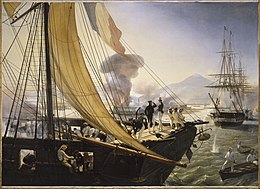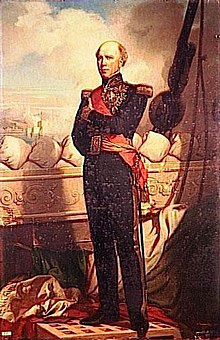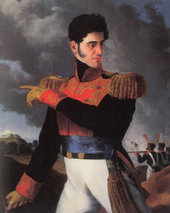Cake war

The Cake War ( Spanish Guerra de los pasteles ) was a military conflict between Mexico and France in 1838/1839 .
history
The time between the founding of the Mexican Republic in 1824 and the Mexican-American War (1846–1848) was troubled. There was much looting and the looted could hardly hope for compensation from the Mexican Republic. Therefore, foreign residents of Mexico often turned to the governments of their home states for compensation for injustices they had suffered.
In Tacubaya , a suburb of Mexico City , there was also a French baker, Monsieur Remontel. His bakery had been ransacked by Mexican officers in 1832, and he turned to the French King Louis-Philippe for help; he wanted 600,000 pesos in compensation for his destroyed bakery. France then demanded 600,000 pesos from Mexico. (For comparison: A Mexican worker earned about one peso a day at that time.) The French ambassador Baron Antoine Louis Deffaudis (1786–1869) gave Mexico an ultimatum. When Mexican President Anastasio Bustamante failed to pay, Louis-Philippe sent a fleet under Rear Admiral Charles Baudin to Mexico to block all Mexican ports in the Gulf of Mexico , to bombard the fortress of San Juan de Ulúa (November 27, 1838) and the port occupied by Veracruz . Mexico then declared war on France on November 30, 1838. In December 1838 the French captured the entire Mexican Navy in Veracruz . The blockade lasted eight months.
This was the first transatlantic use of steamers, as the paddle steamers Phaeton and Metéore were part of Baudin's fleet.
The deposed president, General Antonio López de Santa Anna , who had retired to his hacienda near Xalapa after the Texan War of Independence , was given the task of fighting the French troops. He led the Mexican forces against the French and also won a skirmish against the rearguard of the retreating French, which he presented as a great achievement. His lower leg was injured and had to be amputated . He afforded the bizarre way to build a tomb for his amputated leg and to have it buried with all military honors. From then on, he always held his wooden leg over his head during public appearances on horseback as a symbol of his willingness to make sacrifices for Mexico. In 1841 he was supposed to return to the presidency.
On March 9, 1839, the French troops withdrew after President Bustamante had agreed to pay the 600,000 pesos to the French through British diplomatic mediation .
literature
- Mission de M. Ouseley et du baron Deffaudis à Rio de la Plata . Plon Frères, Paris 1846.
- Lawrence Sondhaus: Navies of Europe. 1815-2002. Longman, Harlow 2002, ISBN 0-582-50613-1 .
Web links
Individual evidence
- ^ David F. Marley: Wars of the Americas. A chronology of armed conflict in the New World, 1492 to the present . ABC-Clio, Santa Barbara 1998, ISBN 0-87436-837-5 , p. 486.
- ↑ Lawrence Sondhaus: Navies of Europe. 1815-2002 , pp. 16-17.

